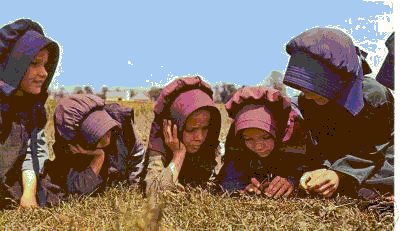 Bats are our friends!
Bats are our friends!But they may be the most misunderstood animals in the United States (if not the World), even though
as consumers of enormous numbers of insects, they rank among the most beneficial.
As a caver, I've encountered quite a few of the little critters...and even rescued a few knocked off their perches by carelessness.
I also saw lots of them in an old mine near my brother's place, while exploring same with him and my nephew a couple of years ago.
Almost all bats in the U.S., and 70% of the bat species worldwide, feed almost exclusively on insects and are thus extremely beneficial. In fact, bats are the
only major predators of night-flying insects. One bat can eat between 600 and 1,000 mosquitoes and other insect pests in just one hour.
While most United States bat species are insectivorous, bats in other parts of the world feed on a variety of items in addition to insects. Many species feed primarily on fruit, while several types feed on nectar and pollen.
Fruit bats perform an extremely important function as seed dispersers. Nectar eating bats, including the federally-listed endangered lesser long-nosed and greater Mexican long-nosed bats, are important pollinators.
Many plant species depend almost entirely on bats for pollination.
Of the 45 species of bats found in the continental United States, six are federally-
listed as endangered under the
Endangered Species Act of 1973, as amended. These species include the gray bat, Indiana bat, Ozark big-eared bat, Virginia big-eared bat as well as the two long-nosed bats mentioned above. In addition to the listed continental U.S. species, the Hawaiian hoary bat (Lasiurus cinereus semotus)(Hawaii), little Mariana fruit bat (Pteropus tokudae)(Guam) and Mariana fruit bat (Pteropus mariannus mariannus)(Guam), are also listed as endangered. Twenty other species are considered to be of special concern and may be proposed for listing as endangered or threatened in the future. Populations of several of the remaining species, especially cave-dwelling species, also appear to be declining.
Of course,
the bat that gives the rest a bad reputation is the
Vampire bat (
Desmodus rotundus).
Vampire bats are one of the few bat species that are considered a pest, but exist only in Latin America.
If not for their diet, people would not pay much attention to these small bats, which feed mostly on livestock.
In Latin America, cattle raising is a growing business, and sleeping cattle attract vampire bats. In ranching areas, control programs have been started.
Unfortunately, millions of
beneficial bats are destroyed by people who mistake them for vampires.
A vampire bat finds its prey with echolocation, smell, and sound. They fly about one meter above the ground. Then they use special heat sensors in their noses to find veins that are close to the skin.
They don't actually suck blood, however; they make tiny cuts in the skin of a sleeping animal, then lap up the blood that oozes from the wound. A chemical in their saliva numbs the animal's skin and keeps them from waking up, and another chemical keeps the blood from clotting.
In fact, scientists have discovered that vampire bat saliva is better at keeping blood from clotting than any known medicine. Vampire bats may one day help prevent heart attacks and strokes.
So the "bad boy" of bats can be a boon to humanity...
Vampire Bats Help Battle Strokes
















